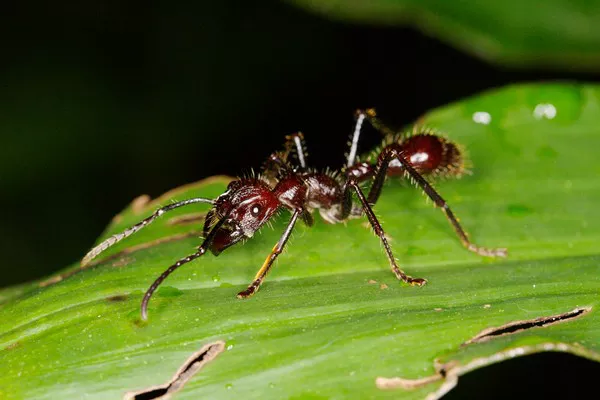In the intricate tapestry of the natural world, ants are renowned for their remarkable diversity and fascinating behaviors. While most ants play crucial roles in ecosystems as scavengers, predators, and seed dispersers, some species possess venomous stings that can cause severe pain and even death in humans. Among these, the bullet ant (Paraponera clavata) stands out as one of the most notorious and feared insects in the world. In this article, we delve into the captivating world of the bullet ant, exploring its biology, venom, ecological significance, and the human fascination and fear it evokes.
Biology of the Bullet Ant
The bullet ant, named for the intense pain caused by its sting, is a species of ant found primarily in the rainforests of Central and South America. It belongs to the family Formicidae and is known for its large size, ranging from 18 to 30 millimeters in length. Characterized by its robust body and distinctive red and black coloration, the bullet ant is an apex predator in its habitat, preying on a variety of insects and other invertebrates.
One of the most remarkable features of the bullet ant is its potent venom, which it delivers through a stinger located at the tip of its abdomen. Unlike bees, which can only sting once before dying, bullet ants are capable of repeatedly stinging their prey or predators, making them formidable adversaries in the insect world.
Venom Composition and Effects
The venom of the bullet ant contains a complex mixture of toxins that induce intense pain, inflammation, and neurotoxic effects in mammals, including humans. The primary component responsible for the excruciating pain caused by the sting is a peptide known as poneratoxin, which activates pain receptors in the nervous system, leading to a sensation likened to being shot with a bullet—hence the ant’s common name.
In addition to pain, bullet ant venom can cause a range of symptoms, including swelling, redness, itching, and numbness at the site of the sting. In some cases, individuals may experience systemic effects such as nausea, headache, fever, and muscle spasms. While deaths from bullet ant stings are rare, severe allergic reactions and anaphylaxis can occur in sensitive individuals, highlighting the importance of prompt medical attention in cases of envenomation.
Ecological Significance
Despite its fearsome reputation, the bullet ant plays a vital role in the rainforest ecosystem as a predator and scavenger. By preying on insects and other invertebrates, bullet ants help regulate populations and maintain ecological balance within their habitat. Additionally, bullet ant colonies contribute to nutrient cycling and soil health through their activities, such as foraging and nest construction.
Furthermore, the presence of bullet ants serves as a deterrent to potential predators, including vertebrates such as birds, reptiles, and mammals. The painful sting of the bullet ant acts as a potent defense mechanism, dissuading predators from preying on the ants or disturbing their nests. This phenomenon, known as aposematism, is common among venomous animals and serves to advertise their toxicity or danger to potential threats.
Cultural Significance and Human Interaction
In addition to its ecological importance, the bullet ant holds cultural significance for indigenous communities in the Amazon rainforest. In some cultures, initiation rituals involve young men enduring the sting of bullet ants as a test of strength, courage, and endurance. Known as “bullet ant gloves” or “ant gloves,” these rituals symbolize the transition from adolescence to adulthood and are believed to imbue participants with spiritual powers and resilience.
Outside of indigenous traditions, the bullet ant has captured the imagination of researchers, adventurers, and entomologists worldwide. Its fearsome reputation and potent venom make it a subject of fascination and study in fields such as ecology, pharmacology, and evolutionary biology. Scientists are investigating the biochemical properties of bullet ant venom for potential medical applications, including the development of novel painkillers and therapeutics.
Conservation Status and Threats
While the bullet ant itself is not considered threatened or endangered, its habitat—the rainforests of Central and South America—is facing significant challenges due to deforestation, habitat destruction, and climate change. Loss of forest cover and fragmentation pose a direct threat to the biodiversity and ecological integrity of these ecosystems, including the populations of bullet ants and other species that depend on them.
Conservation efforts aimed at preserving rainforest habitats and promoting sustainable land use practices are essential for safeguarding the biodiversity of the region, including charismatic and ecologically important species like the bullet ant. By protecting the natural habitats of bullet ants and other rainforest inhabitants, we can ensure the continued existence of these fascinating creatures for generations to come.
A Quick Review
In conclusion, the bullet ant stands as a remarkable example of nature’s ingenuity and complexity—a creature both feared and revered for its potent venom and ecological significance. As apex predators of the rainforest floor, bullet ants play a crucial role in regulating insect populations and contributing to ecosystem health. While their painful sting may inspire fear in humans, it also serves as a reminder of the intricate web of life that exists within Earth’s most biodiverse ecosystems.
As we strive to conserve and protect the world’s rainforests, it is essential to recognize the importance of species like the bullet ant and their role in maintaining ecological balance. By understanding and appreciating the natural world, we can work together to ensure a sustainable future for all living beings, including the formidable bullet ant.
You Might Be Interested In:






















